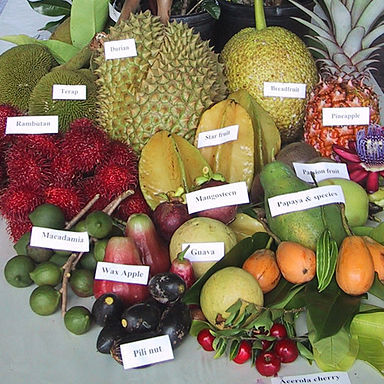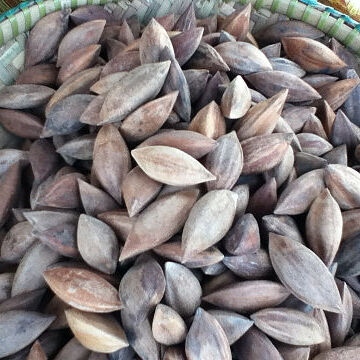Tree up to 20 m by 50 cm. Branchlets 6-12 mm thick, glabrous, lenticellate; pith with many small vascular strands appressed to the wood. Stipules persistent, inserted on the petiole up to 6 mm from its base, deltoid to lingulate, 5-20 by 3-10 mm, acute, stiff-chartaceous, glabrescent. Leaves 2-4-jugate, glabrous. Leaflets ovate to elliptic, 4-24 by 2-12 cm, stiff-coriaceous; base oblique, (cuneate to) rounded to subcordate; margin entire; apex (rather) abruptly acuminate, acumen cuneate to long and slender, blunt; nerves 8-12 pairs (angle 60-90°), straight to faintly curved, rather abruptly or gradually arching at some distance from the margin. Inflorescences axillary, close together at the ends of the branches, narrowly paniculate to nearly racemose, 3-12 cm long, glabrescent, few-flowered; main branches decussate, up to 2.5 cm, with up to 5 flowers. Bracts concave. Flowers (sub)sessile, pubescent, up to 12 mm long, female ones with a slightly concave receptacle. Calyx ♂ 7 mm high, female 8-9 mm. Stamens 6, glabrous, ♂ slightly adnate to the disk, female inserted on the rim of the disk. Disk 6 cylindrical, 3-3.5 mm high, solid, densely tomentose, rim 6-lobed; female adnate to the receptacle, with 6-lobed rim, glabrous. Pistil male none, female glabrous. Infructescences 3-9 cm long, with 1(-2) fruit(s); calyx flat, orbicular, 1.75-2 cm diam. Fruits ovoid to ellipsoid, acute, triangular in cross-section, 3½-6¼ by 2-2¾ cm, glabrous; pyrene triangular in cross-section, the sides slightly furrowed, angle-ribs rounded except at the acute base and apex; lids 1.5-2 mm thick. Seed 1; sterile cells strongly reduced.
More
A medium sized evergreen tree. It grows up to 20 m high. The trunk can be 50 cm across. The small branches are 6-12 mm thick. The vascular bands in the branches are as separate rings like in roots. The leafy structures (stipules) are about 6 mm from the base of the leaf stalk. They are 5-20 mm long by 3-10 mm wide and triangular in shape. The leaves are alternate and with 2-4 pairs of leaflets borne oppositely. The leaflets are smooth and rounded at the base with a pointed tip. They are 4-24 cm long by 2-12 cm wide and stiff and leathery. There are 8-12 pairs of veins which are fairly straight until they curve near the leaf edge. The flower clusters occur in the axils of leaves near the ends of branches. They are 3-12 cm long and with few flowers. The flowers are greenish and with an aroma. The fruit clusters are 3-9 cm long with one or two fruit. The fruit are oval but triangular in cross section. They are 4-6 cm long by 2-3 cm across. There is one seed inside the triangular shell.
A tropical plant. It suits the hot humid lowland tropics. Common in southern Luzon, Bicol regions and in primary forest at low and medium altitudes and also in Polillo, Samar, Leyte and Surigao in the Philippines. They occur from sea level up to 500 m in the Philippines. It suits hardiness zones 11-12.
More
Forests where rainfall is abundant. Low to medium elevations in primary and secondary forests.
Primary forests, up to 500 m. FL May-July, fr. Oct.-Dec.(-June).
Uses. One of the sources of manila-elemi (together with C. luzonicum A. GRAY) and the Main source of pili nuts, which are used as almonds, and of pilinut oil ( W. H. BROWN Min. Prod. Philip. For. 2 1921 114, 300 f. 40 BURK. Dict. 1935 431 Quis. Med. PL Philip. 1951 476, 1036 ) and pili-pulp oil ( L. T. MARANON et al. Philip. J. Sc. 83 1955 359 ).
More
The kernels of the nuts are eaten raw or roasted. They can upset the stomach when raw. They can also be used to produce an oil that is used in cooking. The pulp of the fruit is boiled and eaten. They are also pickled. The young shoots are eaten in salads.



